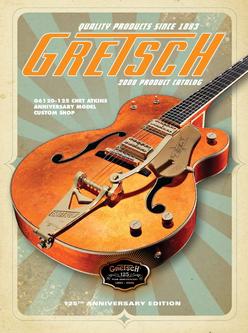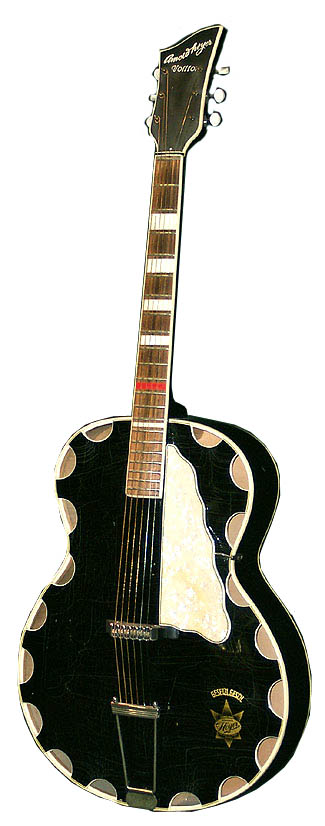When
As I alluded to, Bachman is a collector of Hoyer guitars. When it comes to guitars, Hoyer is one of Germany's best-kept secrets. The company started in 1874 and to this day is building excellent guitars. In my opinion, the guitars they produced in the 1950’s through the 1960’s are the best. The wood is beautiful, the woodworking is classic with the German Carve on the bodies perimeter, the f-holes are unique to Hoyer and included a lightening bolt style and a cats eye style reminiscent of Rickenbacker guitars. These guitars are works of art and craftsmanship.
As for some background, in 1874, Franz Hoyer Joseph , opened his own shop at this time to concentrate on building classic and folk guitars. By 1945, Hoyer had to leave Schönbach, which was the town his family had lived. At the end of the ware, the town became part of the Czech Republic Erlangen . Erlangen Fred Wilfer Arnold took over the company.
By 1948, Hoyer guitars were making a name as preeminent Jazzgitarran in Germany
Arnold Hoyer passed away in 1967 and his son Walter took over the business. Walter concentrated mainly on the line of electric guitars and classical instruments. Quality, design and beautiful wood were hallmarks of Hoyer. During the 1960’s, Hoyer even invented a guitar with a foldaway neck.
In 1977, Walter Hoyer
In 2005,AMC Compernass, a company owned by Michael Compernass UK LTD entered into an agreement with AMC for the purchase of Hoyer. Compernass Germany Far East .
However the golden years of Hoyer stretched from 1945 to the end of the 1960's, when they produced gorgeous German-crafted, hand-built guitars.
The top-of-the-line guitar for Hoyer is the Special SL. This guitar combines many of the features of the Bianka and the Special. The body is similar to the Hoyer Special, but has black or white pearloid inlay surrounding the top, much like the Bianka. The top and bottom sides are bound with large herringbone inlay. The top is carved spruce and the back and sides are flamed maple. The Special SL has cats eye tone holes that are bound with herringbone inlay. The controls come mounted on a metal plate. On some models the controls mounted in the traditional manner. The usual Hoyer rolling bridge is used. The bound neck is flamed maple and came with a traditional ebony fretboard with bow-tie style markers. It also came with a white plasticized fretboard with black bow-tie position markers. The tailpiece was elaborate and interesting.
In 2005,
However the golden years of Hoyer stretched from 1945 to the end of the 1960's, when they produced gorgeous German-crafted, hand-built guitars.
The top-of-the-line guitar for Hoyer is the Special SL. This guitar combines many of the features of the Bianka and the Special. The body is similar to the Hoyer Special, but has black or white pearloid inlay surrounding the top, much like the Bianka. The top and bottom sides are bound with large herringbone inlay. The top is carved spruce and the back and sides are flamed maple. The Special SL has cats eye tone holes that are bound with herringbone inlay. The controls come mounted on a metal plate. On some models the controls mounted in the traditional manner. The usual Hoyer rolling bridge is used. The bound neck is flamed maple and came with a traditional ebony fretboard with bow-tie style markers. It also came with a white plasticized fretboard with black bow-tie position markers. The tailpiece was elaborate and interesting.
One of the most beautiful instruments was the Hoyer Bianka. The body is carved from spruce, with unusual engraving. This engraved top is emphasized by the German carve. The top of the body bears a beautiful pearloid border and bound by a white plastic inlay. But for the pickups and controls, the back of the body mirrors the front. The sound-holes are lightening bolt style, the body is extra wide, the neck is flame maple with laminated mahogany strips, and the six individual tuners have engraved buttons. In the break between the neck and headpiece is a large volute.
The fretboard is bound ebony with sort of bow-tie inlays. The metal roller bridge saddle is unique and so is the tailpiece. The roller bridge is unusual since the guitar does not have a vibrato. The controls sit on a chromed metal pad on the lower bout. The parallelogram pickups are unique to Hoyer guitars. Looking closely, the output jack is an old-styleDIN plug. The sunburst Bianka is even more stunning.
The fretboard is bound ebony with sort of bow-tie inlays. The metal roller bridge saddle is unique and so is the tailpiece. The roller bridge is unusual since the guitar does not have a vibrato. The controls sit on a chromed metal pad on the lower bout. The parallelogram pickups are unique to Hoyer guitars. Looking closely, the output jack is an old-style
The Hoyer Special does not have the engraving of the Bianka, or the German carve or even the lightening bolt inlays. It is a more subtle instrument with bound cats eye sound holes and a beautiful tailpiece. The arched top is carved from spruce and the back and sides are flame maple. Both front and back come bordered with herringbone inlay. The neck is laminated with maple and mahogany. The bound ebony fretboard is similar to the Bianka’s and has a zero fret. The tuners had engraved pegheads.
This guitar also came as a twin pickup electric model with the Hoyer parallelogram pickups. It was available in with a natural or red sunburst finish. Some models have the metal plate to house the controls. Later models have more traditional controls that were mounted into the wood. This guitar came in acoustic or electric models. Some of the electric models featured the Hoyer parallelogram pickups and others featured pickups that appear to be made by DeArmond.
This guitar also came as a twin pickup electric model with the Hoyer parallelogram pickups. It was available in with a natural or red sunburst finish. Some models have the metal plate to house the controls. Later models have more traditional controls that were mounted into the wood. This guitar came in acoustic or electric models. Some of the electric models featured the Hoyer parallelogram pickups and others featured pickups that appear to be made by DeArmond.
A most unusual guitar manufactured by Hoyer sometimes did not bear the Hoyer logo. Instead, the headstock read Herr Im Frack or Gentleman Dressed for the Evening. This all black hollow archtop bore a small round soundhole as well as twin cats eye soundholes. The black non-cutaway body was bound, front and back, in white pearloid inlay.
The neck was bound in white and came with a rosewood fretboard inlaid with white blocks, except for the 12th fret, which had a red marker, mimicking a bowtie. The guitar had the zero fret, which is found on most Hoyers. The usual Hoyer roller bridge saddle was paired with a beautiful gold-plated tailpiece. The headstock was bound in white and bore the name HerrIm Frack
Hoyer also produced a very unusual model, somewhat similar to the Herr Im Frack. They called this the Volttal. The instrument was not as fancy. It bore the Hoyer logo. The bizarre feature was the 18 individual sound holes that surrounded the body's perimeter.
The neck was bound in white and came with a rosewood fretboard inlaid with white blocks, except for the 12th fret, which had a red marker, mimicking a bowtie. The guitar had the zero fret, which is found on most Hoyers. The usual Hoyer roller bridge saddle was paired with a beautiful gold-plated tailpiece. The headstock was bound in white and bore the name Herr
Hoyer also produced a very unusual model, somewhat similar to the Herr Im Frack. They called this the Volttal. The instrument was not as fancy. It bore the Hoyer logo. The bizarre feature was the 18 individual sound holes that surrounded the body's perimeter.
The Hoyer Soloist was a beautiful guitar. Different models had different features. It came in a very plain natural version with a spruce top and maple back, sides and neck. The body was bound with white inlay, the bound neck featured an ebony fretboard with small position markers. The headstock came with 3 white pearloid inlays. The machine heads were plain with pearloid buttons. A fancier version of the Soloist was also available with a multi-striped top that featured alternating strips of spruce and mahogany. It was bound with triangulated wood pieces.
Without a doubt the most bizarre Hoyer guitar was the Fantastik model. This was sort of an experimental instrument that Hoyer created and sold. Due to its unusual construction, it became known as the organ guitar.
Without a doubt the most bizarre Hoyer guitar was the Fantastik model. This was sort of an experimental instrument that Hoyer created and sold. Due to its unusual construction, it became known as the organ guitar.
The body is constructed of six wooden pipes or tubes lined up in three differing lengths. Each pipe is an individual resonator and each has a sound hole. The beautifully carved body is lined with a dark binding. The back of the guitar is flat.
The guitars accoutrements include a trapeze tailpiece, the Hoyer roller bridge; white binding on the back of the body and Hoyer fancy butterfly shaped tuning buttons. The guitars ebony fretboard came bound in white and came with unusual white inlays, but for the 12th fret, which had a red inlay.
The unusual pointed headstock came bound with black and white strips and adorned in fancy script announcing this was an Arnold Hoyer guitar. A DeArmond floating pickup attached to the scratchplate topped the body and contained the output jack, volume, and tone control.
As futuristic, well constructed, and thought out as this instrument was, according to those that played it, the instrument did not have much of an acoustic sound. However, it was surely and eye catcher.
Though many US music stores offer new Hoyer guitars, one would be hard pressed to find a used Hoyer in the USA. They occasionally show up on eBay.eBay.
Though many US music stores offer new Hoyer guitars, one would be hard pressed to find a used Hoyer in the USA. They occasionally show up on eBay.eBay.
















Tidak ada komentar:
Posting Komentar